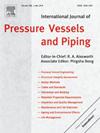Automated finite element analysis of burst capacity for corroded pipelines
IF 3
2区 工程技术
Q2 ENGINEERING, MECHANICAL
International Journal of Pressure Vessels and Piping
Pub Date : 2025-02-25
DOI:10.1016/j.ijpvp.2025.105489
引用次数: 0
Abstract
Accurate prediction of pipeline burst pressure is critical for ensuring the safe and efficient operation of energy pipelines. Conventional empirical solutions compromise burst pressure prediction accuracy for complex corrosion with irregular profiles or multiple defects, leading to unnecessary repairs. Albeit significantly more accurate, the three-dimensional finite element modeling requires substantial efforts, which limits its use in pipeline burst pressure assessment. This paper presents an innovative automated finite element method (FEM) for elastic-plastic analysis of corroded pipelines, applicable to both straight pipelines and pipeline elbows. The method integrates MATLAB and ANSYS to automate key manual steps, including defect geometry reconstruction, mesh generation, and post-processing analysis for the burst pressure prediction of pipelines containing both semi-elliptically idealized and realistic corrosion defects. Validation against full-scale burst test data demonstrates excellent agreement, with the developed FEM accurately predicting the burst capacity for corroded straight pipelines and elbows. The method developed will greatly reduce manual efforts for finite element modeling and facilitate pipeline assessment of complex irregular corrosion defects.
腐蚀管道爆破能力的有限元自动分析
管道爆破压力的准确预测是保证能源管道安全高效运行的关键。传统的经验解决方案会降低具有不规则轮廓或多个缺陷的复杂腐蚀的破裂压力预测精度,导致不必要的修复。三维有限元模型虽然精度更高,但需要大量的工作,这限制了其在管道爆裂压力评估中的应用。本文提出了一种适用于直管和弯管腐蚀管道弹塑性分析的自动化有限元方法。该方法将MATLAB和ANSYS集成在一起,对含有半椭圆理想腐蚀缺陷和现实腐蚀缺陷的管道进行破裂压力预测,实现缺陷几何重构、网格生成和后处理分析等关键人工步骤的自动化。与全尺寸爆破试验数据的对比验证表明,所建立的有限元模型能够准确地预测腐蚀直管和弯头的爆破能力。所开发的方法将大大减少人工有限元建模的工作量,便于对复杂的不规则腐蚀缺陷进行管道评估。
本文章由计算机程序翻译,如有差异,请以英文原文为准。
求助全文
约1分钟内获得全文
求助全文
来源期刊
CiteScore
5.30
自引率
13.30%
发文量
208
审稿时长
17 months
期刊介绍:
Pressure vessel engineering technology is of importance in many branches of industry. This journal publishes the latest research results and related information on all its associated aspects, with particular emphasis on the structural integrity assessment, maintenance and life extension of pressurised process engineering plants.
The anticipated coverage of the International Journal of Pressure Vessels and Piping ranges from simple mass-produced pressure vessels to large custom-built vessels and tanks. Pressure vessels technology is a developing field, and contributions on the following topics will therefore be welcome:
• Pressure vessel engineering
• Structural integrity assessment
• Design methods
• Codes and standards
• Fabrication and welding
• Materials properties requirements
• Inspection and quality management
• Maintenance and life extension
• Ageing and environmental effects
• Life management
Of particular importance are papers covering aspects of significant practical application which could lead to major improvements in economy, reliability and useful life. While most accepted papers represent the results of original applied research, critical reviews of topical interest by world-leading experts will also appear from time to time.
International Journal of Pressure Vessels and Piping is indispensable reading for engineering professionals involved in the energy, petrochemicals, process plant, transport, aerospace and related industries; for manufacturers of pressure vessels and ancillary equipment; and for academics pursuing research in these areas.

 求助内容:
求助内容: 应助结果提醒方式:
应助结果提醒方式:


